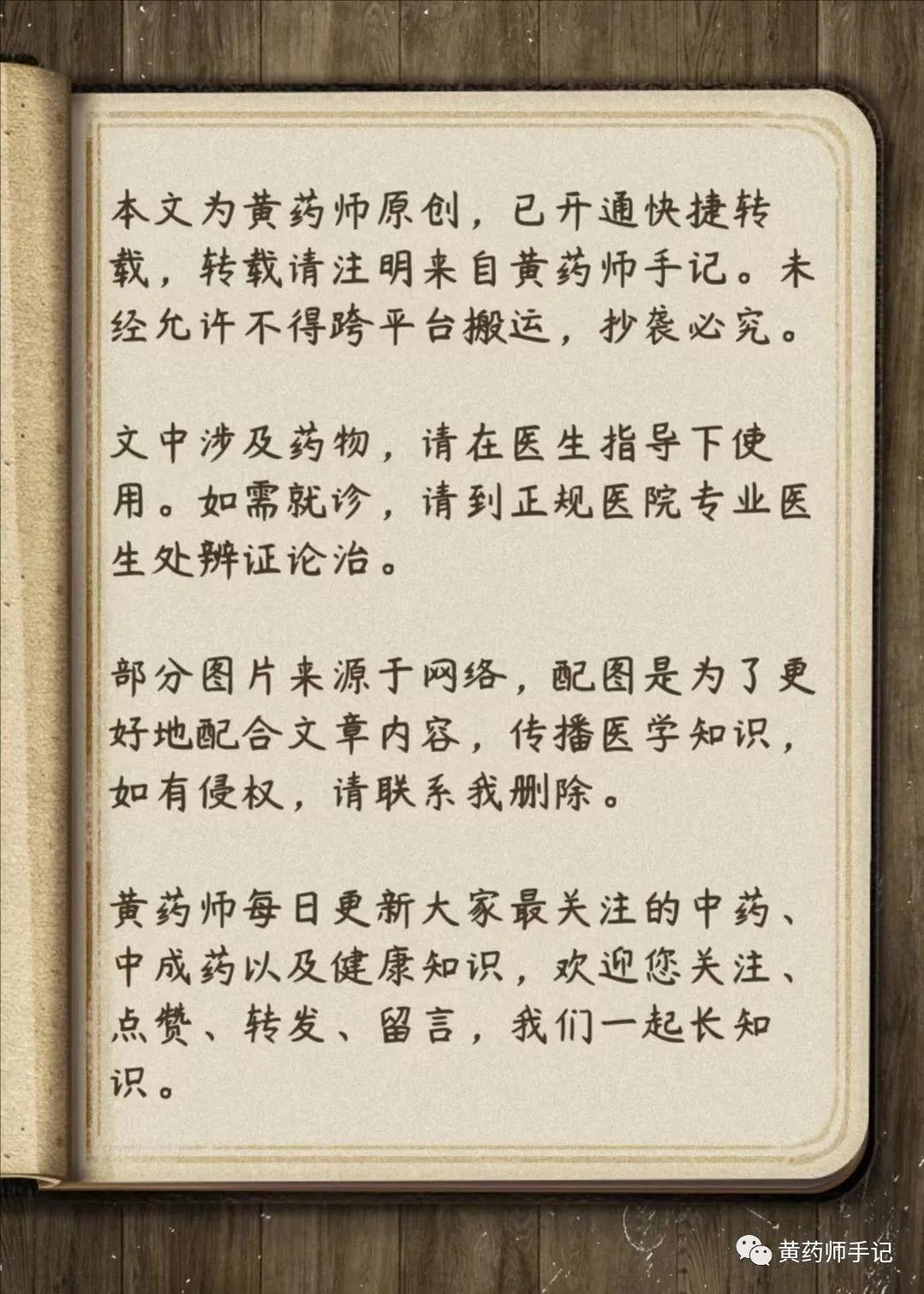Wind-heat colds commonly occur in the warmer seasons of spring, summer, and autumn, but there is also a possibility of contracting a wind-heat cold in a warmer room during winter.In the later stages of a wind-cold cold, when wind-cold transforms into heat, symptoms of wind-heat may also appear.However, a true wind-heat cold is characterized bythe absence of the initial cold phase seen in wind-cold colds, which includes symptoms like clear nasal discharge, sneezing, and aversion to cold. Instead, it presentswith immediate symptoms such as dry and itchy throat, discomfort, sore throat, followed by rapid onset of fever, body aches, tonsillitis, yellow phlegm, and cough. Yesterday, we discussed several common Chinese patent medicines for wind-cold colds (6 common Chinese patent medicines for wind-cold colds, applicable for influenza, COVID-19, pneumonia, and other infections). Today, Huang Yaoshi will talk about common Chinese patent medicines for wind-heat colds, which can be referenced for treating influenza, COVID-19, mycoplasma pneumonia, and respiratory syncytial virus infections.1. Yin Qiao Jie Du Wan/Pian (Yin Qiao Detoxification Pills/Tablets)
Yesterday, we discussed several common Chinese patent medicines for wind-cold colds (6 common Chinese patent medicines for wind-cold colds, applicable for influenza, COVID-19, pneumonia, and other infections). Today, Huang Yaoshi will talk about common Chinese patent medicines for wind-heat colds, which can be referenced for treating influenza, COVID-19, mycoplasma pneumonia, and respiratory syncytial virus infections.1. Yin Qiao Jie Du Wan/Pian (Yin Qiao Detoxification Pills/Tablets)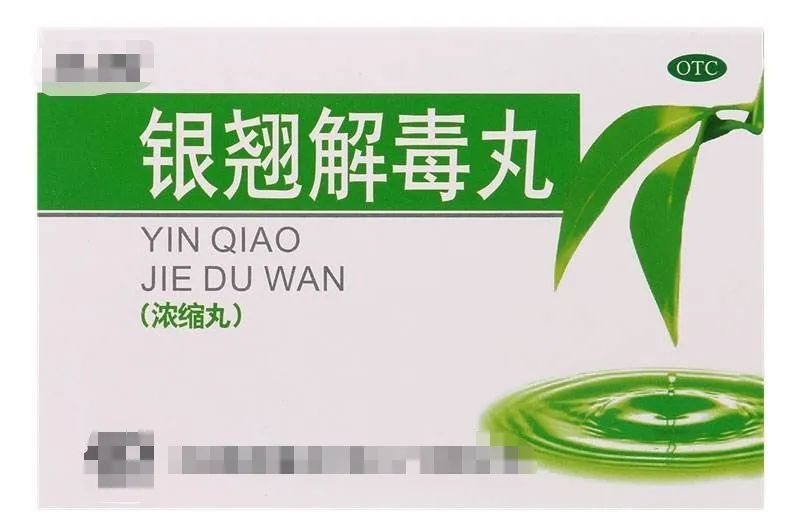 Image for reference only; please use Chinese patent medicines under the guidance of a physician.Ingredients: Lian Qiao (Forsythia), Jin Yin Hua (Honeysuckle), Jie Geng (Platycodon), Bo He (Mint), Zhu Ye (Bamboo Leaf), Jing Jie Sui (Schizonepeta), Dan Dou Chi (Fermented Soybean), Niu Bang Zi (Burdock Seed), Gan Cao (Licorice).Derived from the ancient formula Yin Qiao San, it is used for wind-heat colds or the initial stages of warm diseases.Common symptoms include fever, no sweating, or sweating that is not smooth, slight aversion to wind, slight aversion to cold, headache, thirst, cough, sore throat, red tongue tip, thin white or slightly yellow coating.It is commonly used for influenza, acute tonsillitis, epidemic mumps, pharyngitis, and other conditions classified as wind-heat.Note:(1) There is another medicine called Refined Yin Qiao Jie Du Pian, which differs from Yin Qiao Jie Du Pian as it contains the antipyretic Western medicine component acetaminophen, so please distinguish between them.
Image for reference only; please use Chinese patent medicines under the guidance of a physician.Ingredients: Lian Qiao (Forsythia), Jin Yin Hua (Honeysuckle), Jie Geng (Platycodon), Bo He (Mint), Zhu Ye (Bamboo Leaf), Jing Jie Sui (Schizonepeta), Dan Dou Chi (Fermented Soybean), Niu Bang Zi (Burdock Seed), Gan Cao (Licorice).Derived from the ancient formula Yin Qiao San, it is used for wind-heat colds or the initial stages of warm diseases.Common symptoms include fever, no sweating, or sweating that is not smooth, slight aversion to wind, slight aversion to cold, headache, thirst, cough, sore throat, red tongue tip, thin white or slightly yellow coating.It is commonly used for influenza, acute tonsillitis, epidemic mumps, pharyngitis, and other conditions classified as wind-heat.Note:(1) There is another medicine called Refined Yin Qiao Jie Du Pian, which differs from Yin Qiao Jie Du Pian as it contains the antipyretic Western medicine component acetaminophen, so please distinguish between them. (2) If fever is more severe, using this medicine may be less effective; please switch to a stronger heat-clearing medication.2. Feng Re Gan Mao Ke Li (Wind-Heat Cold Granules)
(2) If fever is more severe, using this medicine may be less effective; please switch to a stronger heat-clearing medication.2. Feng Re Gan Mao Ke Li (Wind-Heat Cold Granules)
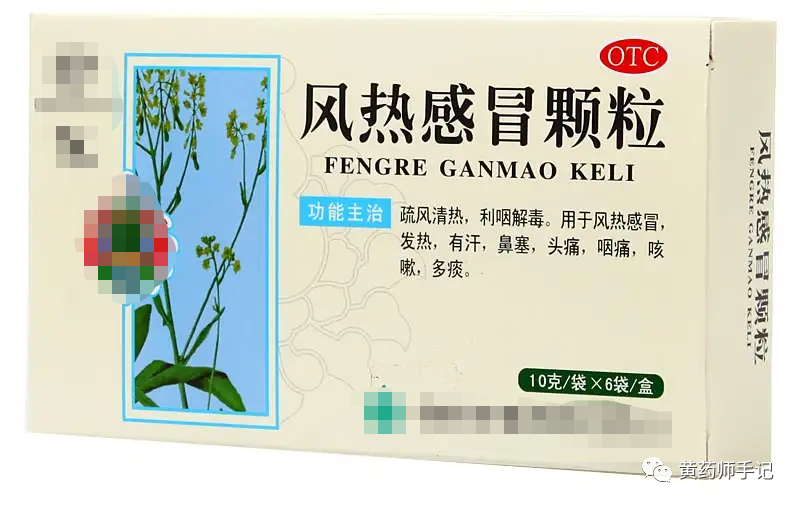
Image for reference only; please use Chinese patent medicines under the guidance of a physician.
Ingredients: Ban Lan Gen (Isatis Root), Lian Qiao (Forsythia), Bo He (Mint), Niu Bang Zi (Burdock Seed), Ju Hua (Chrysanthemum), Ku Xing Ren (Bitter Apricot Kernel), Sang Zhi (Mulberry Branch), Lu Gen (Reed Rhizome), Sang Ye (Mulberry Leaf), Liu Shen Qu (Fermented Grain), Jing Jie Sui (Schizonepeta).Used for wind-heat colds, with symptoms of fever, sweating, nasal congestion, headache, sore throat, cough, and phlegm.As the name suggests, this medicine is specifically for various symptoms of wind-heat colds.3. Sang Ju Gan Mao Pian/Ke Li (Sang Ju Cold Tablets/Granules)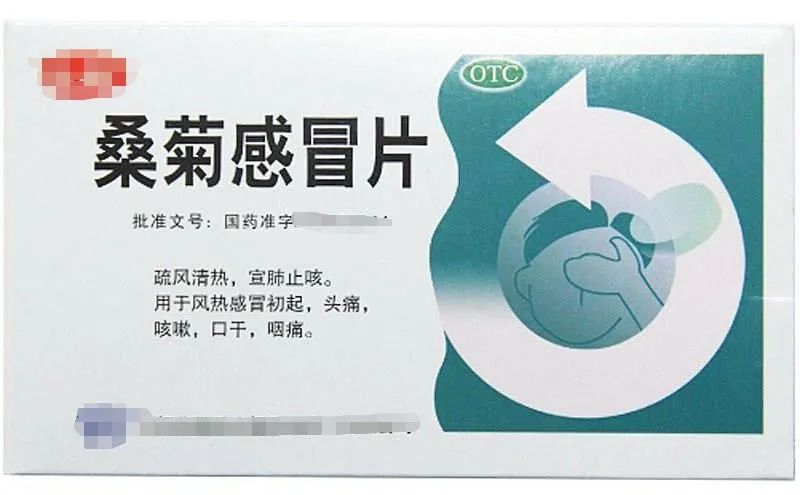 Image for reference only; please use Chinese patent medicines under the guidance of a physician.Ingredients: Sang Ye (Mulberry Leaf), Ju Hua (Chrysanthemum), Jie Geng (Platycodon), Xing Ren (Apricot Kernel), Bo He (Mint Oil), Lian Qiao (Forsythia), Lu Gen (Reed Rhizome), Gan Cao (Licorice).Derived from the ancient formula Sang Ju Yin, it is used for the initial stages of wind-heat colds.Common symptoms include cough, slight fever, headache, mild thirst, sore throat, red tongue, thin white coating, and rapid pulse.Note:This medicine is only suitable for the initial stages of wind-heat colds, with mild fever. If fever is more severe, using this medicine may be less effective; please switch to a stronger heat-clearing medication.4. Anti-Viral Oral Liquid
Image for reference only; please use Chinese patent medicines under the guidance of a physician.Ingredients: Sang Ye (Mulberry Leaf), Ju Hua (Chrysanthemum), Jie Geng (Platycodon), Xing Ren (Apricot Kernel), Bo He (Mint Oil), Lian Qiao (Forsythia), Lu Gen (Reed Rhizome), Gan Cao (Licorice).Derived from the ancient formula Sang Ju Yin, it is used for the initial stages of wind-heat colds.Common symptoms include cough, slight fever, headache, mild thirst, sore throat, red tongue, thin white coating, and rapid pulse.Note:This medicine is only suitable for the initial stages of wind-heat colds, with mild fever. If fever is more severe, using this medicine may be less effective; please switch to a stronger heat-clearing medication.4. Anti-Viral Oral Liquid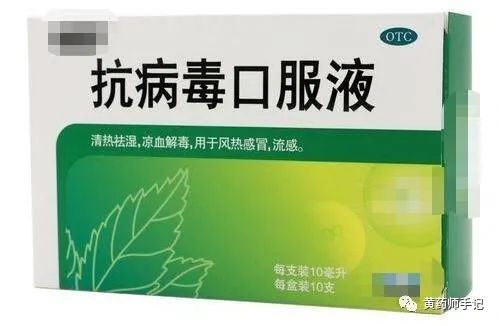 Image for reference only; please use Chinese patent medicines under the guidance of a physician.Ingredients: Ban Lan Gen (Isatis Root), Shi Gao (Gypsum), Lu Gen (Reed Rhizome), Sheng Di Huang (Rehmannia), Yu Jin (Curcuma), Zhi Mu (Anemarrhena), Shi Chang Pu (Acorus), Guang Huo Xiang (Patchouli), Lian Qiao (Forsythia).Used for wind-heat colds, influenza, fever, cough, and sore throat.This medicine cannot be judged by its name; do not be misled by it. Although it is called “anti-viral,” it is not limited to antiviral effects; it is also effective for other bacterial and mycoplasma infections classified as wind-heat.Chinese medicine’s concept of antiviral differs from Western medicine; it does not directly kill viruses but rather exerts a systemic regulatory effect.5. Lian Hua Qing Wen Jiao Nang/Ke Li (Lian Hua Qing Wen Capsules/Granules)
Image for reference only; please use Chinese patent medicines under the guidance of a physician.Ingredients: Ban Lan Gen (Isatis Root), Shi Gao (Gypsum), Lu Gen (Reed Rhizome), Sheng Di Huang (Rehmannia), Yu Jin (Curcuma), Zhi Mu (Anemarrhena), Shi Chang Pu (Acorus), Guang Huo Xiang (Patchouli), Lian Qiao (Forsythia).Used for wind-heat colds, influenza, fever, cough, and sore throat.This medicine cannot be judged by its name; do not be misled by it. Although it is called “anti-viral,” it is not limited to antiviral effects; it is also effective for other bacterial and mycoplasma infections classified as wind-heat.Chinese medicine’s concept of antiviral differs from Western medicine; it does not directly kill viruses but rather exerts a systemic regulatory effect.5. Lian Hua Qing Wen Jiao Nang/Ke Li (Lian Hua Qing Wen Capsules/Granules)
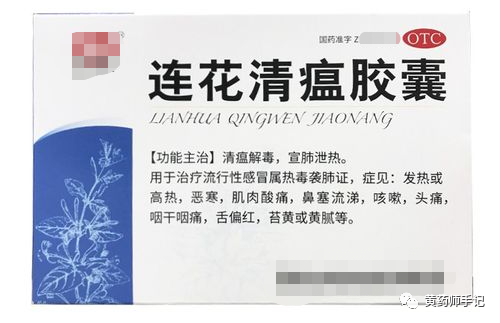
Image for reference only; please use Chinese patent medicines under the guidance of a physician.Ingredients: Lian Qiao (Forsythia), Jin Yin Hua (Honeysuckle), Zhi Ma Huang (Processed Ephedra), Chao Ku Xing Ren (Fried Bitter Apricot Kernel), Shi Gao (Gypsum), Ban Lan Gen (Isatis Root), Mian Ma Guan Zhong (Euphorbia), Yu Xing Cao (Houttuynia), Guang Huo Xiang (Patchouli), Da Huang (Rhubarb), Hong Jing Tian (Rhodiola), Bo He Nao (Menthol), Gan Cao (Licorice).Commonly used for influenza, COVID-19, and other respiratory infectious diseases (epidemics), classified as heat toxin attacking the lungs, symptoms are usually more severe than ordinary wind-heat colds. Common symptoms include fever, aversion to cold, muscle aches, nasal congestion with runny nose, cough with headache, dry and sore throat, red tongue, yellow or greasy coating.Note:(1) Lian Hua Qing Wen is not a preventive medicine for influenza or COVID-19; it is not recommended to purchase in bulk for stockpiling.(2) This medicine contains many heat-clearing ingredients and includes Da Huang (Rhubarb), so those with a tendency for spleen and stomach deficiency or prone to diarrhea should use it cautiously.6. Xiao Chai Hu Ke Li (Xiao Chai Hu Granules)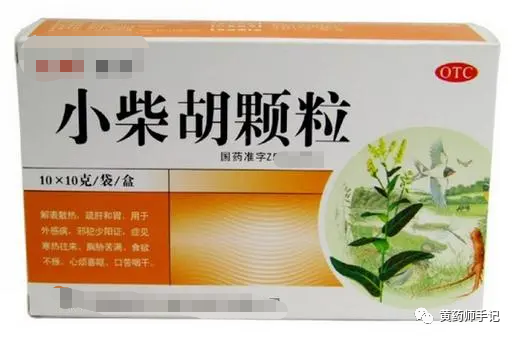 Image for reference only; please use Chinese patent medicines under the guidance of a physician.Ingredients: Chai Hu (Bupleurum), Jiang Ban Xia (Pinellia), Huang Qin (Scutellaria), Dang Shen (Codonopsis), Gan Cao (Licorice), Sheng Jiang (Fresh Ginger), Da Zao (Jujube).Used for external pathogenic diseases, classified as Shao Yang syndrome, with symptoms including alternating chills and fever, fullness in the chest and hypochondria, poor appetite, irritability, nausea, bitter mouth, and dry throat (any one of these symptoms can indicate the use of Xiao Chai Hu).Colds may sometimes present with alternating chills and fever, which is a struggle between the body’s righteous qi and external pathogenic evil. When the righteous qi prevails, the body feels hot; when the evil qi prevails, there is aversion to cold. Thus, the body may exhibit alternating symptoms of cold and heat.This condition does not accurately belong to wind-cold or wind-heat; in TCM, it is referred to as “evil attacking Shao Yang” or “Shao Yang syndrome,” where the evil qi is in a half-exterior, half-interior state.Additionally, colds caused by emotional issues such as unhappiness, as well as colds during a woman’s menstrual period, can also be treated with Xiao Chai Hu.Huang Yaoshi’s Tips1. The above medicines are not suitable for wind-cold colds, which present with aversion to cold, clear nasal discharge, sneezing, and white phlegm.2. Most Chinese patent medicines for wind-heat are slightly cold in nature; those with spleen and stomach deficiency should use them cautiously based on personal conditions, either reducing the dosage or supplementing with warming foods or medicines for the spleen and stomach.3. The above medicines are generally taken for 3-5 days. If symptoms do not significantly improve after 3 days of medication, or if there are other severe symptoms such as chest tightness or palpitations, one should seek medical attention.
Image for reference only; please use Chinese patent medicines under the guidance of a physician.Ingredients: Chai Hu (Bupleurum), Jiang Ban Xia (Pinellia), Huang Qin (Scutellaria), Dang Shen (Codonopsis), Gan Cao (Licorice), Sheng Jiang (Fresh Ginger), Da Zao (Jujube).Used for external pathogenic diseases, classified as Shao Yang syndrome, with symptoms including alternating chills and fever, fullness in the chest and hypochondria, poor appetite, irritability, nausea, bitter mouth, and dry throat (any one of these symptoms can indicate the use of Xiao Chai Hu).Colds may sometimes present with alternating chills and fever, which is a struggle between the body’s righteous qi and external pathogenic evil. When the righteous qi prevails, the body feels hot; when the evil qi prevails, there is aversion to cold. Thus, the body may exhibit alternating symptoms of cold and heat.This condition does not accurately belong to wind-cold or wind-heat; in TCM, it is referred to as “evil attacking Shao Yang” or “Shao Yang syndrome,” where the evil qi is in a half-exterior, half-interior state.Additionally, colds caused by emotional issues such as unhappiness, as well as colds during a woman’s menstrual period, can also be treated with Xiao Chai Hu.Huang Yaoshi’s Tips1. The above medicines are not suitable for wind-cold colds, which present with aversion to cold, clear nasal discharge, sneezing, and white phlegm.2. Most Chinese patent medicines for wind-heat are slightly cold in nature; those with spleen and stomach deficiency should use them cautiously based on personal conditions, either reducing the dosage or supplementing with warming foods or medicines for the spleen and stomach.3. The above medicines are generally taken for 3-5 days. If symptoms do not significantly improve after 3 days of medication, or if there are other severe symptoms such as chest tightness or palpitations, one should seek medical attention.

Recommended Reading:
[Chronic Gastritis, Atrophic Gastritis, Cancer, commonly used Chinese medicine to tonify qi and nourish blood, support righteousness and combat cancer, can be used for tea infusion]
[A type of Chinese medicine that can be eaten as a vegetable, tonifying spleen deficiency, transforming dampness, detoxifying alcohol, and reducing obesity]
[Chronic Pharyngitis, sore throat, itchy throat, foreign body sensation, commonly used Chinese medicine to help clear the throat and moisten the throat]
[It is the first medicine for soothing the liver and relieving depression, commonly used for breast hyperplasia, foreign body sensation in the throat, and chest tightness and depression]
[Tonifying qi and blood, tonifying spleen and lung, supporting righteousness and expelling evil, it is the most commonly used qi-tonifying medicine]
[Stops cough above, consolidates essence below, stops sweating externally, and stops diarrhea internally; this medicine can both tonify and consolidate]
